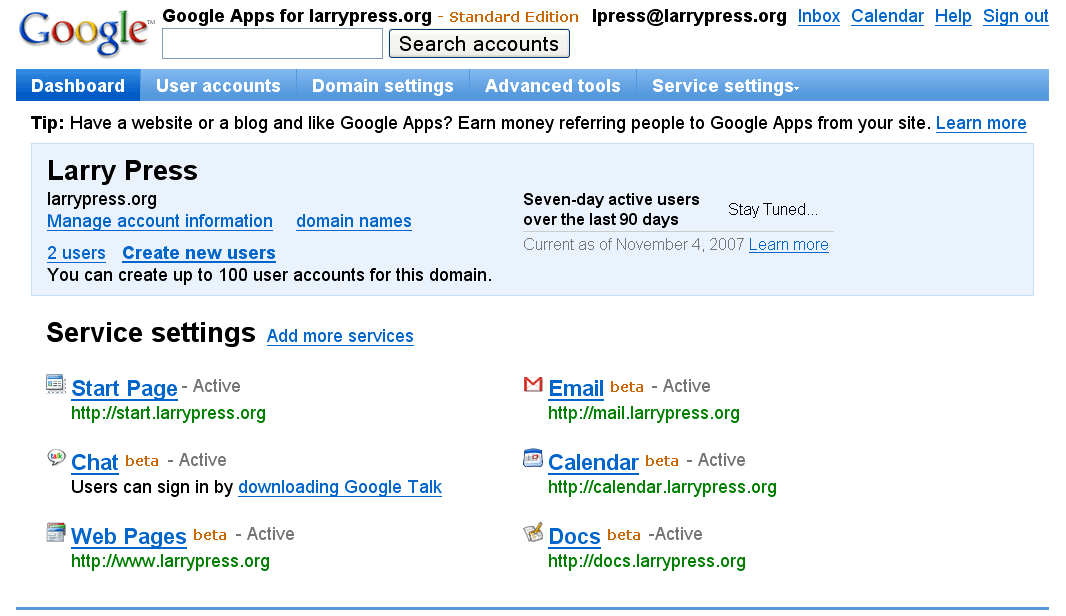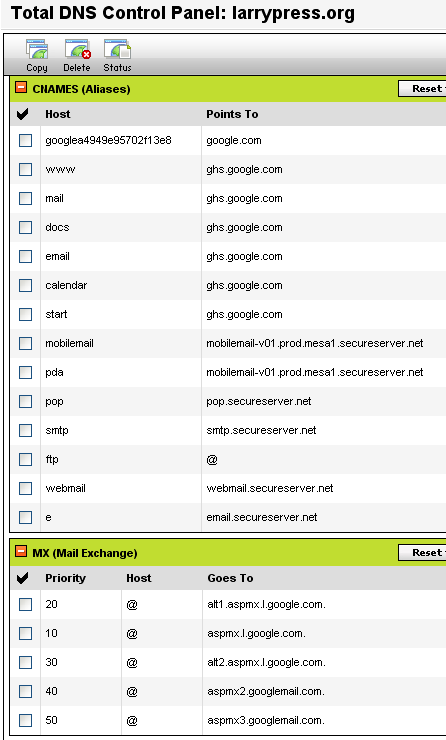
Consider the example of larrypress.org, a demonstration organization. The first step in establishing an online presence was purchasing the domain name. I selected Godaddy.com as the domain registrar because their fee is reasonable, and they provide online control over the DNS.
Next I established a free Google Apps account for larrypress.org. Google apps generated an administrative "dashboard" like the one shown below, and I used their online help for subsequent steps.
I set up a user account for each member of the organization. Each user received an email address and 2 gigabytes of searchable email storage, a calendar and the ability to create and share documents.
Then I verified to Google that I actually owned the domain name larrypress.org. Google offers two verification methods, and the simplest is to add a new CNAME record to the DNS. Google generates a random alias for your account, and checks the DNS to see that you have added a CNAME record pointing that random alias to google.com.
Once that was done, I could change the URLs of the various applications. Initially they were:
user's start page: http://partnerpage.google.com/larrypress.orgWhile these URLs work, it is obvious that they are hosted on Google. To complete the personalization process, I updated the domain DNS records with the proper aliases (as shown below) so the URLs were simplified to:
user's calendar page: http://www.google.com/calendar/a/larrypress.org
user's docs page: http://docs.google.com/a/larrypress.org
user's email page: http://mail.google.com/a/larrypress.org
organization Web site: http://www.larrypress.org-a.googlepages.com/home
user's start page: http://start.larrypress.org(You can also set the DNS so several domains, for example, larrypress.org and larrypress.com, link to the same servers).
user's calendar page: http://calendar.larrypress.org
user's docs page: http://docs.larrypress.org
user's email page: http://mail.larrypress.org
organization Web site: http://www.larrypress.org
The Google Apps applications all have application program interfaces (APIs) that enable a programmer to modify and extend them. There is also a community of third party developers who use these APIs to provide add-on software and services for organizations using Google Apps. If Google Apps catches on, Google hopes many developers will create applications that add to the value of the service.
Google is marketing this service to large and small organizations, and several universities are using it. A limited version, without APIs and some other features and limits on the number of users and storage, is free.
Using the account administrator's dashboard, one can manage user profiles, and domain names, configure applications and the user's default start page, etc.

When I had finished configuring Google Apps for larrypress.org, the CNAME and MX records in the DNS were:

You can also check DNS settings using a service like Dig or DNSstuff.